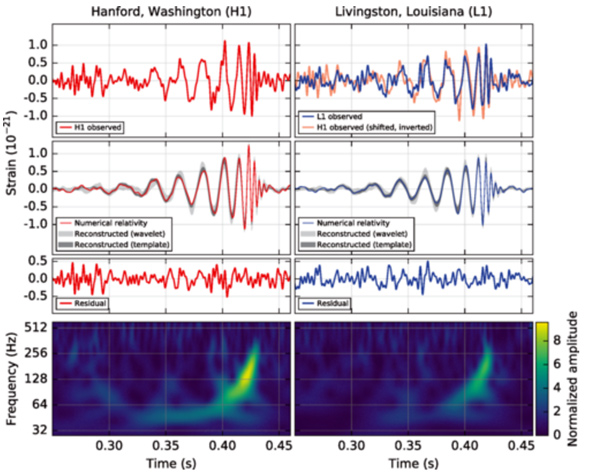You may have heard about the announcement this morning that the LIGO project has finally confirmed the detection of a gravitational wave, a phenomenon predicted by Einstein’s General Relativity theory, but never before actually seen. In fact, this observation is considered to be the last component in verifying the GR theory.
More importantly, the fact that we can now detect gravitational waves may begin a whole new era of astronomy because it allows us to “see” things that we never could before. In the case of this first observation, scientists were able to determine (with a very good degree of confidence, but not an absolute certainty) that the wave was caused by the merger of two black holes. The mass of both original black holes and that of the resulting single black hole have been deduced from the data.
Gravitational waves are distortions in spacetime (the “fabric” of spacetime in Einstein’s description) that propagate through the universe at the speed of light. These distortions actually cause an extremely small change in physical distances as the wave passes through any matter. The LIGO facilities (one in Louisiana and one here in Washington state) each consist of 2 very long tunnels at right angles to each other, with a laser at the vertex and a mirror at the far end of each tunnel. Initially, the system is adjusted such that the laser beam returning from one path is exactly 180 degrees out of phase with the other, so that when they are combined they cancel each other and there is no signal. But when the length of either path is distorted by a gravitational wave the phase shifts, producing a signal. There are two such facilities so that anomalous signals caused by earthquakes and such can be ignored. In this case, the signals at both facilities matched very well, including a 7 millisecond time difference corresponding to the speed of light between the them.
For more information about LIGO and today’s announcement see https://www.ligo.caltech.edu/. For a simplified discussion of the finding (but more detailed than mine) see http://www.slate.com/blogs/bad_astronomy/2016/02/11/gravitational_waves_finally_detected_at_ligo.html.
 A semi-interesting side note to this announcement is that you will probably be hearing some talk about whether it is OK to refer to the waves as “Gravity Waves” rather than “Gravitational Waves”. The issue is simply that the former term is “taken” already for use in a very different context having to do with the behavior of clouds in certain situations. Language issues like this are common in science, where people like to be precise and unambiguous in their communications. In fact, the field of “astronomy” probably should be (and used to be) called “astrology”, but that word evolved into something very different – something that is widely shunned by astronomers. I was thinking that we could avoid the problem by instead calling it a “Space-Time Distortion” wave, but this would undoubtedly get abbreviated and lead to unfortunate headlines such as “Scientists see waves of STD”.
A semi-interesting side note to this announcement is that you will probably be hearing some talk about whether it is OK to refer to the waves as “Gravity Waves” rather than “Gravitational Waves”. The issue is simply that the former term is “taken” already for use in a very different context having to do with the behavior of clouds in certain situations. Language issues like this are common in science, where people like to be precise and unambiguous in their communications. In fact, the field of “astronomy” probably should be (and used to be) called “astrology”, but that word evolved into something very different – something that is widely shunned by astronomers. I was thinking that we could avoid the problem by instead calling it a “Space-Time Distortion” wave, but this would undoubtedly get abbreviated and lead to unfortunate headlines such as “Scientists see waves of STD”.